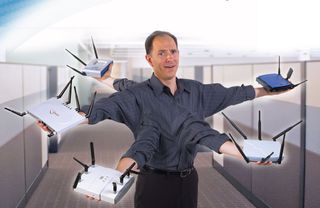Beamforming: The Best WiFi You’ve Never Seen
Conclusion
I don’t need to sell you on how the world is moving to being video-centric. If you’ve stuck with us this far, it’s probably because you see the writing on the wall and know that you’re either going to have to string Ethernet cabling through your walls or else find some sort of wireless solution for your present and future video needs. Moreover, CAT5e or CAT6 only get you so far. The day when most of us have more video-oriented devices in our pockets than on our desks and walls can’t be far off. Woe to the hapless consumer who doesn’t have a wireless backbone up to the task of distributing streams wherever needed.

I don’t want you to walk away from this article with the single message: “Ruckus rocks!” That’s not the point. What we’ve seen here is that on-chip beamforming, at least in the way that Cisco has implemented it on the 1142, barely has any effect. No wonder the feature arrives disabled today. However, beamforming in principal can have a tremendous effect. Ruckus clearly shows that all 802.11n up to present has merely been a preface. This is the next level, and so far there’s only one company standing on it.

My hope is that this article will raise some eyebrows and spur the industry to advance. With the 1142, Cisco largely relied on existing designs. The level of innovation was minimal, and it shows. We need more companies like Ruckus willing to invest two or three years into rethinking the problem and taking wireless communications forward in multiples of performance, not single-digit gains. Yes, there will be interoperability wars. Yes, the pricing will be double what you pay for non-beamforming equivalents. But in return, we’ll be able to do and enjoy things with our wireless LANs that simply can’t be done today.
Stay on the Cutting Edge
Join the experts who read Tom's Hardware for the inside track on enthusiast PC tech news — and have for over 25 years. We'll send breaking news and in-depth reviews of CPUs, GPUs, AI, maker hardware and more straight to your inbox.
Current page: Conclusion
Prev Page Chariot At 5 GHz Next Page Angelini Weighs In On Beamforming At Home-
pirateboy just what we need, more retarded failnoobs clogging up the airwaves with useless braindead movieclips...yaayReply -
bucifer This article started up pretty good with lots of technical data and the beamforming technology in theory but after that the goodness stopped.Reply
1.You cannot compare two products by testing them with a in-house developed software. It's like testing ATI vs nVIDIA with nvidia made benchmark.
2.If you do something get it done, don't just go with half measures. I don't care if you didn't have time. You should have planned this from the beginning. The tests are incomplete, and the article is filled with crap of Rukus and Cisco. -
Mr_Man In defense of your wife, you didn't HAVE to use that particular channel to view all the "detail".Reply -
@Mr_Man: With a name like yours, I'd think that you'd sympathize with Chris a bit more :P Unless (Mr_Man == I likes men) :DReply
-
Pei-chen Both Tyra and Heidi have personal issues and would be pretty difficult friend/mate.Reply
The network idea sounds better. I couldn’t get my 10 feet g network to transmit a tenth as much as my wired network without it dropping.
-
zak_mckraken There's one question that I think was not covered by the article. Can a beamformaing AP can sustain the above numbers on two different clients? Let's say we take the UDP test at 5 GHz. The result shows 7.3 Mb/s. If we had two clients at opposite sides of the AP doing the same test, would we have 7.3 Mb/s for each test or would the bandwidth be sliced in 2?Reply
The numbers so far are astonishing, but are they realistic in a multi-client environnement? That's something I'd like to know!
Most Popular

